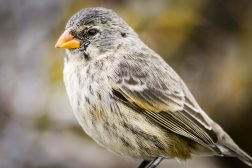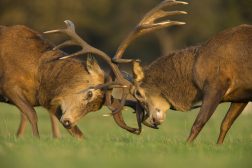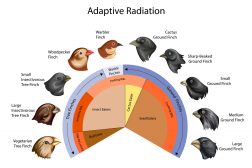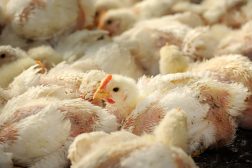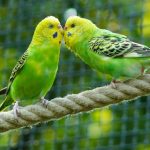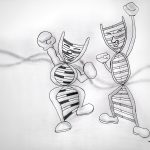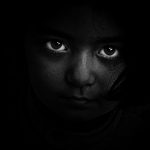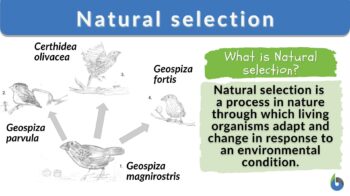
Natural Selection
n., ˈnætʃəɹəl//səˈlɛkʃən
The process by which heritable traits increase an organism’s chances of survival and reproductionCredit: Jackie Malvin, (CC BY-SA 4.0 )
Table of Contents
Natural Selection Definition
What is natural selection in biology? Natural selection is defined as a process in nature through which living organisms adapt and change in response to an environmental condition. And organisms that are better suited to their environment tend to survive longer and produce more offspring.
Different conditions incline a particular organism to acquire an adaptive trait. These traits will then, be passed on to the next generations. Over time, these traits will become more common as they predominate over other traits in the population.
According to Urry et al., (2016) natural selection refers to the differential survival and reproduction of individuals. It is a vital mechanism of evolution where there is a change in heritable traits of a population over generations.
The basic idea of natural selection is that individuals are naturally variable, meaning that each one is different in some ways. This variation exists within organisms, and changes occur at random. It will be passed on to the next offspring.
Natural selection occurs when some of these changes help an organism to survive and produce more than others, causing their genes to become more common in the population over time.
Because the environment is continuously changing, no organism is construed as perfectly suited or absolutely adapted to its environment. It will always be selective on certain organisms possessing certain genetic combinations. This makes natural selection an essential driving force in evolution.
Natural Selection Explanation
Let us try to understand the principles underlying natural selection. Even if parents were adapted perfectly to the environment, yet, somehow the environment changes, their offspring tend to adapt to the changing environment in an attempt to thrive despite the limited resources and to win over the competition with the other inhabitants. By then, the most fitted organisms will be favored to reproduce. As a result, those that are able to survive will be able to pass their traits or genes to the next generation.
The genetic variability of an organism causes each individual to be slightly different. These differences lead them to reproduce more by creating individuals that are more adjusted to succeed. The organism without these genetic adaptations will not reproduce further. As a result, their lines eventually cease to exist.
The process of natural selection causes the populations to become adapted to their environment over time. The individuals in a population inherit the traits that help them survive environmental stressors, such as the presence of predators and food availability.
Those individuals that inherited the traits will tend to have more offspring in the next generation compared to their peers. These helpful traits will allow them to be more effective at surviving and reproducing. Resources are limited in nature, where individuals with favorable traits increased their frequency over generations.
Natural selection is described as differential reproduction. Some organisms that carry favorable genetic variants that tend to increase survival have higher reproductive success than those that carry alternative genetic variants. Selection happens as a result of differences in survival, mating success, development, and fertility.
History of Natural Selection
The theory of natural selection is based on direct observation of the British naturalist, Charles Darwin, during the HMS Beagle voyage that was set to travel around the world from 1831-1836. He saw that the same organism manifested variations in appearances at different geographical locations. By then, he partially proposed that such physical changes were an adaptation of the organisms to their environment. But before Darwin’s theory of natural selection, there were other evolutionary thoughts deserving explanation as well.
Pre-Darwinian Theories
Jean Baptiste Chevalier de Lamarck (1744-1829) was the first evolutionary theorist to publicly proclaim his idea about the process that leads to biological change. He was one of the advocates of spontaneous generation, a theory that was once popular believing that living organisms appear spontaneously from non-living materials and they gradually change into a more complex form as they continuously strive for perfection. (Pre-Darwinian Evolutionary Theory, 2015)
A theory was credited to his name. Known as Lamarckianism, the theory was based on Lamarck’s idea that evolution was due mostly to the inheritance of characteristics as the organisms adapt to their environments. (Pre-Darwinian Evolutionary Theory, 2015)
He believed that the human race was the ultimate product of this goal-oriented evolution. (Pre-Darwinian Evolutionary Theory, 2015)
In The Inheritance of Acquired Characters, Lamarck asserted that evolution occurs when an organism uses the body part in such a way that it eventually gets altered during its lifetime. This change could then be inherited by its offspring.
He explicated this theory in giraffes acquiring long necks over time as an example. He believed that the ancestors of giraffes were originally short-necked. As the giraffes keep stretching their necks to get leaves for food, their necks eventually became longer with each generation. This change in body shape was likely inherited progressively.
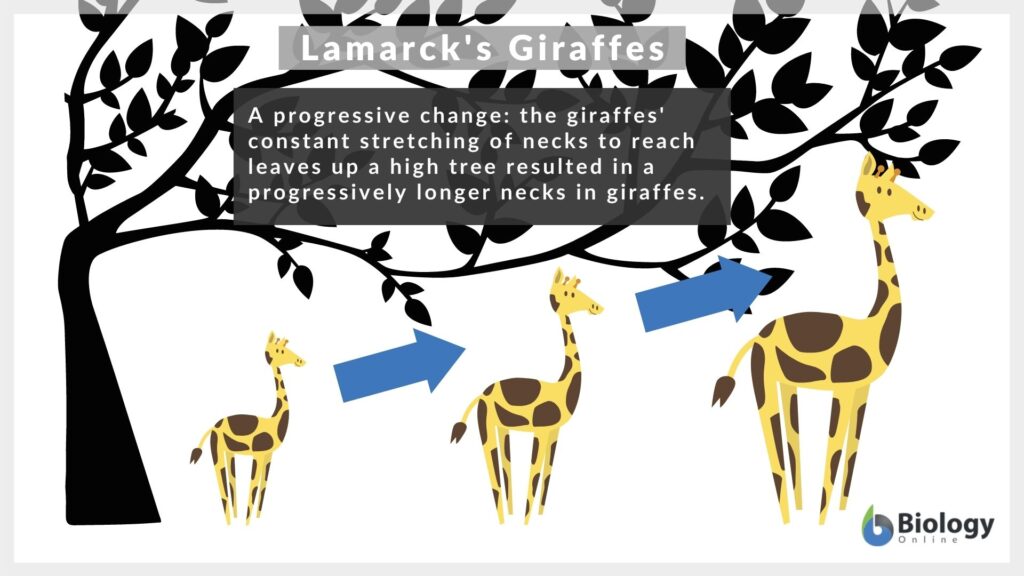
Another example is the wading birds, like herons and egrets. They seemed to have evolved their long legs by stretching them to remain dry.
Lamarck also believed that organisms could develop new organs that change the structures and functions of the old ones.
This theory, however, is no longer as popular as it was when it was discredited by more modern evolutionary thoughts and research. Although his theory was incorrect, he was an instrument in directing scientific discoveries toward the founding of evolutionary biology.
George Cuvier (1769-1832) was a French scientist who discredited Lamarck’s Inheritance of Acquired Characters. Nevertheless, he still believed that there was an earlier life form. Cuvier was the first scientist who documented the extinction of ancient animals. He was an expert on dinosaurs. Cuvier believed that “species were fixed and did not change” (Brown (2007).
Another pre-Darwinian school of thought was Catastrophism. Its naturalist advocates were Joseph Fourier and Comte de Buffon. The theory was based on the idea that catastrophic events transformed the Earth. Catastrophists believe that the Earth started out as a hot ball of molten rock, which eventually cooled. (Uniformitarianism: Charles Lyell, 2020).
This school of thought was disputed by Charles Lyell (1797 – 1875), an English lawyer and geologist when certain naturalists linked catastrophism to the Bible. (Uniformitarianism: Charles Lyell, 2020).
Lyell wanted to found geology as a science far from theological aspects. Thus, he turned to James Hutton’s ideas that led to the conception of the school of thought, Uniformitarianism.
Lyell asserted that throughout time Earth had undergone slow processes rather than a huge catastrophe. These gradual processes, such as weathering, deposition, lithification, etc. transformed the Earth as we see it today. He described these natural forces as a force that changed the shape of the earth’s surface.
Both Lyell and Hutton, though, saw the Earth’s history as something vast and directionless. Lyell believed that the processes that altered the Earth were uniform through time.
In terms of the history of life, this has no merit. Nevertheless, this revolutionary idea contributed to the understanding of Charles Darwin about biological evolution in the 1830s. George Cuvier and Charles Lyell strongly rejected the idea of biological evolution. Cuvier did not live long enough to know about Charles Darwin’s proof of evolution. However, Lyell did learn about it and came to accept this proof in the early 1860s, and he became a friend of Charles Darwin. Today, our world has been shaped by occasional catastrophic events. All of these events have possibly affected the rate and direction of biological evolution.
Darwin’s theory
Throughout the expedition of Charles Darwin, he saw an intriguing pattern in the distribution and physical features of organisms. One of these remarkable patterns he noticed was the species of finches on the Galapagos island.
These birds were not identical species, each species were well-suited to its environment and role. For instance, some birds that eat large seeds tend to have large and tough beaks. Other birds that ate insects had thin and sharp beaks. However, Darwin did not know that these finches were related until he presented his sample to an ornithologist (bird biologist).
Gradually, he developed an idea that explained the pattern of different finches. According to him, this pattern was possible if the Galapagos island before had been populated by birds from the mainland.
Finches might have slowly adapted to the local conditions over a long period leading to the formation of distinct species on each island.
With this idea, Darwin developed the Theory of Evolution by Natural Selection. It states that species can change over time and that new species arises from pre-existing species. Therefore, species share a common ancestor that, gradually, diverged from the original species and became a new species.
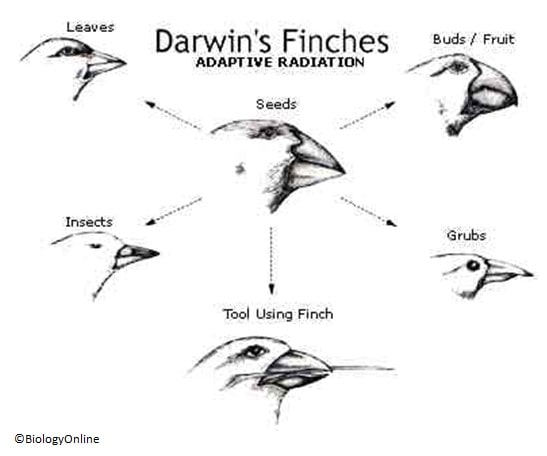
Read: Darwin and Natural Selection (tutorial)
Evolution by natural selection is one of the best-validated theories in the history of science. This theory has two main points. First, all life forms on earth are related and connected. Second, this diversity of life is the product of modification by natural selection, where some traits were favored in the environment over others. All of these are the theory of Charles Darwin’s natural selection.
Darwin’s theory of evolution by natural selection entails the following fundamental ideas:
- Traits are often heritable. This means organisms have inherited traits for them to survive and reproduced in given environmental conditions. When an individual has helpful characteristics, produces more offspring, and passes it to the next generation.
- More offspring produced than the environment can support it. Thus, competition occurs among the population for limited resources. This competition includes a lack of food resources, habitat, and mates. Because helpful traits are heritable in which parents can leave these traits to their offspring, these traits then become more common in a population.
- Offspring with inherited characters allows them to best compete for limited resources. These individuals will then survive and have more offspring than those individuals with less variation to compete. Because characteristics are inherited, the said characters will then be represented in the next generation. Through this, the population will change over the successive generation. Darwin called this process descent with modification.
Principles of Natural Selection
How does natural selection work? Here are some explanations that may help you get a better sense of it.
First, natural selection depends on the environment. It does not favor the superior trait but favors the traits that are beneficial for survival and reproduction in a specific area. Characteristics that are helpful in a particular habitat may be harmful to another.
Second, natural selection acts on the existing heritable traits. This heritable variance serves as a starting material for natural selection to act upon. Third, heritable variations come from random changes or mutations in the genes. The random mutations of genes result in new variants of traits that are heritable.
Below are the four fundamental principles of natural selection that Charles Darwin originally outlined in his book The Origin of Species:
Variation: Individuals in a population exhibit variation in behavior and appearance. This variation includes color, height, weight, and other characteristics. Each individual with favorable variations will change the frequency of traits within the population. However, some organisms show more variation than others due to specific conditions in their environment. As a result, these populations evolve a very distinct characteristic. Like for example, moths of the same species with different wing colors. Moths having similar colors to the tree bark are better able to camouflage themselves than moths of a different one. Thus, tree-colored moths are likely to survive, reproduce, and pass on their genes.
Inheritance: Inherited traits that are advantageous for survival are more likely to be passed on to subsequent generations. For natural selection to occur, an individual must have a heritable trait that is strongly influenced by environmental conditions. These advantageous traits are said to be selected or favored by natural selection. Over time, unsuccessful characteristics will disappear, and the successful ones becomes more common. However, when differences are high enough, then a new species will evolve. We look at the example of the Galapagos finches; the variations of the beaks are “selected” by natural selection. This change of traits has been inherited by the succeeding generations and became more common, forming a new distinct species. Overall, the better-adapted organisms are, therefore, able to pass on their advantageous characteristics to their offspring through inheritance.
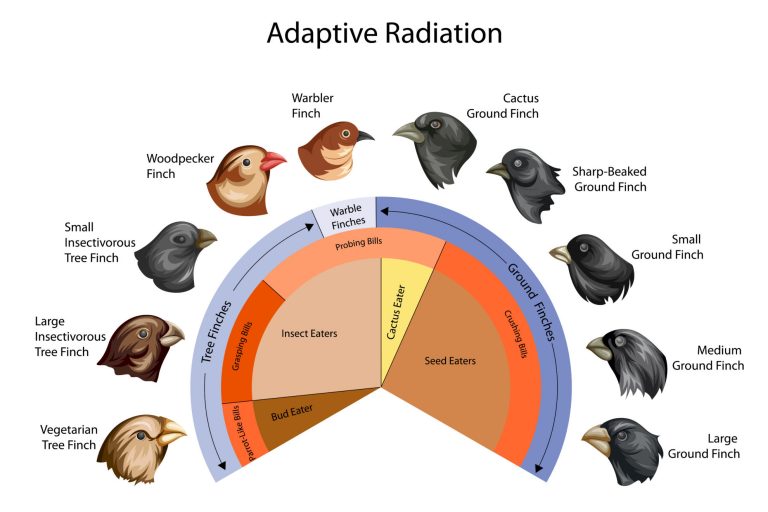
High rate of population growth: Populations produce more offspring each year than the environment can support, leading to a struggle for resources. Each generation experiences significant mortality as members of the population compete for the limited availability of natural resources. Only then, the surviving individual can pass on the characteristics to the next generation. Most of the species are considered to overproduce, for example, fish lay millions of eggs at one time, yet only a fraction of those survive. Sea turtles lay eggs around 70 to 190 at a time, but only 1 out of 100 typically will survive. Though overproduction appears to be like a death sentence, there are benefits to it. Fish and turtles have plenty of predators, so an increase in production also increases the chance of survival. It helps to improve the genetic line by supporting the survival of the fittest. The best individuals able to adapt to environmental challenges can survive. The best genes will be passed on then to the next generation making the species stronger as a whole.
Reproductive advantage: It means by which the visible expressed characteristics of organisms can change over time. These advantageous traits are passed along to offspring and confer a reproductive benefit in a population having a favorable trait. Having positive traits means more of these traits are present in the following generation. For example, the peacock has a magnificent long tail to attract mates, giving them a reproductive advantage. The moths that camouflage to the bark of the tree to avoid predators and able to reproduce, give moths a survival advantage. For plants, they increase their spectrum of potential pollinators, giving plants a reproductive advantage. There are factors in reproductive advantage to consider such, as mate choice and sexual selection, which is why reproductive advantage is different from fitness. Parental care is also a factor since taking better care of offspring often gives an advantage in later life. However, it is quantified over generations, since organisms negate the effects of the variation in a single year or breeding season.
Principles of Evolution
What are the four principles of evolution? How are these principles being carried out in natural selection? The four principles of evolution by Charles Darwin are presented below.
Competition: Each generation produces more individuals in a given environment. These individuals, however, compete with each other for natural resources. Resources that make them survive and have a chance to pass on their genes to the next generation. Moreover, competition can either be intraspecific or interspecific. Intraspecific competition occurs among members of the same species. For example, two lizards of the same species compete for mates in the same area. This kind of competition is the common factor of natural selection that leads an organism to have better adaptation in the population. Another type is interspecific competition in which members of two different species compete. For example, predators of different species, in the same area compete for the same prey. This type of competition may lead the other species to go extinct. If that species is less adapted and gets fewer resources than the two different species need.
Heritable differences: Genetic or trait differences can be found within the individual in the population. These differences are apparent as both visible and invisible traits that can be beneficial or not. The variation then is preferred and essential, as it will provide a higher chance of species survival. Moreover, heritability is a concept that entails how much variation in a given trait is qualified for genetic variation. It is said to be specific from one population in the same environment and changed over time as circumstances change. Like for example, the melanism of the peppered moth in England. Industrialization produces air pollution in the area, and soot from factories makes the tree darker. We know that formerly the peppered moth has a light color to blend the bark of the tree and lichens. In this case, dark moths became more abundant than light moths as the latter became vulnerable to predators.
Survival of the Fittest: Genetic variance of an individual tends to be well-suited to their environment for survival and reproduction. Fitness refers to advantageous traits- endurance, strength, speed, social skills, intelligence, etc. that help organisms to survive. Though forces affecting survival were not equally the same for individuals, there were always variations. These variations would confer fitness over the others. We looked again at the example of peppered moths; the dark moth becomes more fit to the changing environment. As the dark moth’s fitness increased, it was able to survive and reproduce. While light moths decrease in numbers, fitness is not favorable for them. Fitness denotes survival and reproduction in a specific environment.
Descent with Modification: A formation of a new species from a common ancestor due to reproductive isolation. There is a diversion of genetic characteristics that allow organisms to emerge distinctly from a common ancestor. For example, a population of tortoises on Galapagos Island has a longer neck than those tortoises that live on dry lowlands. The long-necked tortoises are selected because they could reach more leaves and access better food. When drought occurs, fewer leaves will be available on the islands. Those that can grasp more leaves have a better chance of surviving than those who could not reach the leaves. As a result, long-necked tortoises are more likely to be reproductively successful. By then, the long-necked trait will be passed on, to their offspring. In time, only long-necked tortoises will be available in the population. Because traits are inherited, these traits will be represented in the next generation. It will then lead to a change in a population over generations through a process called descent with modification.
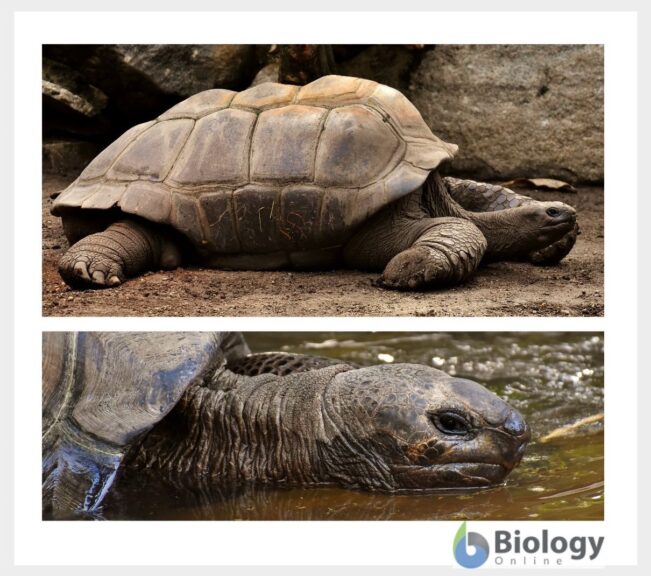
Types of Natural Selection
What are the different types of natural selection? Let’s find out below.
Stabilizing selection
It happens when natural selection favors the intermediate states of character against the extreme character variation to survive. Like for example, the height of the plants, the small plant received less sunlight compared to the tall plant. However, tall plants are vulnerable to wind disruption. Given these two pressures, the plant will maintain a medium height. Over time small plants and tall plants decrease in number while the medium plants continue to increase. In this scenario, the plants undergo stabilizing selection. The plant diversity decreases as the population stabilizes on a particular trait value- the medium plants. This type of selection pushes the trait towards the average instead of extremes. Simply, stated that the cause of stabilizing selections increased the reproductive success that the median individual has. These extreme traits have a disadvantage in one way or another, thus decreasing reproduction.
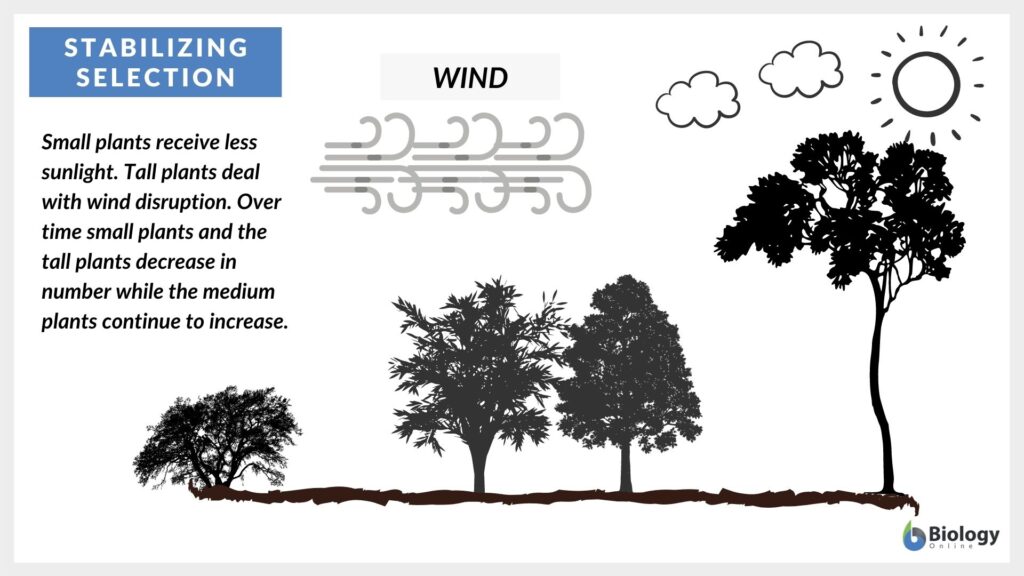
Directional selection
In directional selection, it occurs when a single phenotype is favored, causing the frequency to shift into one direction. The population trait distribution will change toward the other extreme trait. In this case, a classic example is a peppered moth in England. Before the industrial revolution, peppered moths are naturally light in color to blend in with light-colored trees and lichens. However, when air pollution from the industries makes trees darker in color. The light-colored moths on darkened trees become vulnerable for predators to spot. Peppered moths shift over time to become darker in color to camouflage dark-colored trees. The number of darker moths increases as they have a higher survival rate in habitats affected by air pollution. When the environment changes often, the population undergoes directional selection. Thus, there is a shift of population genetic variance towards new fit phenotypic variance. When the characteristic falls at one end, and, the other phenotypic spectrum is favored over the others, the selection is directional.
Diversifying or disruptive selection
This type of selection removes an individual from the center of a phenotypic distribution. It occurs when natural selection favors both extreme continuous variations. In this selection, the distribution becomes bimodal. Two extreme variations will become more common that eventually lead to two new distinct species. Like for example, coloration allows an organism to match or blend its background to prevent recognition from predators. In the case of oysters, light-colored oysters are more hidden than intermediate-colored oysters. Dark-colored oysters, on the other hand, blend into the shadows of the rocks. Hence, intermediate-colored oysters are more vulnerable to being eaten by crabs. The light-colored and dark-colored oysters will survive and reproduce. This type of selection that produces more variations is called polymorphism.
Sexual selection
The organism that is more capable of securing mates is said to be more fitted to the environment. The existence of a particular trait among members of one sex can somehow gain attraction to the opposite sex. Like for example, in Drosophila flies, some of them have yellow body coloration as a result of spontaneous mutation. In contrast, others have normal yellowish-gray pigmentation. Yellowish gray coloration male is more preferred to yellow-colored males by female flies. Another example is the stags (male deer). The antlers of stags increase prowess in competition. Thus, in a contest of strength, those with better antlers have the advantage of winning and securing a mate. Thus, sexual selection leads to increased size and aggressiveness in males. The ultimate goal of sexual selection is to reproduce in which an individual needs to maximize the ability to obtain a mate and produce viable offspring. Sexual selection is also referred to as nonrandom differential reproduction as a result of differential access to mates and reproductive labors. Like, for example, in the peacock tail, when sexual selection favors the evolution of conspicuous courtship structures, then it enhances mating success.
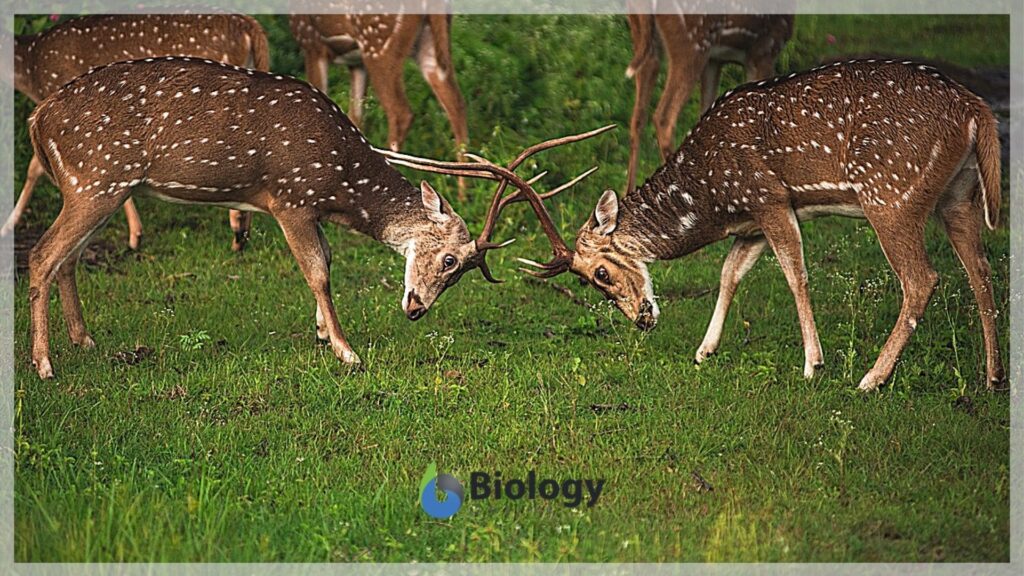
Predator-Prey selection
This type of natural selection is an interaction between organisms in which the predator captures and eats the part or whole body of the other organism-the prey. Predators and prey often have advantageous traits arising from natural selection that help them perform better in the environment. For instance, prey has a defense adaptation to escape from predators. These defenses vary in nature and might be chemical, mechanical, and behavioral. For example, the millipede has both chemical and body defenses. It produces a noxious substance and curls into a defensive ball when threatened. Many organisms used their coloration or body shape to avoid predators. For example, the chameleon changes color to blend with its surroundings. Over time the process of natural selection can change the organism to make them better predators and more defensive prey. Either way, adaptation changes the entire predator-prey dynamic. If an organism cannot adapt with an appropriate defense, it may somehow go extinct. The predator-prey relationship often forms an “evolutionary arms race” that evolves to counter the other.
Kin selection
This type of natural selection involves altruistic behavior. Kin selection occurs when natural selection favors traits or character that benefits related members of the groups. For instance, worker bees show altruistic behavior by spending their lives working in the hive but never having an opportunity to reproduce on their own. However, all bees in the hives are close relatives. The traits of the worker bees will be passed on to the next generation indirectly through the queen. So, the queen produced more related offspring resulting in higher fitness of the worker bee even though it never reproduces directly. It appears that worker behavior would not be promoted or maintained by natural selection. Because any factor causing such behavior seems likely to be eliminated from the population. Since it is not from worker bees’ differential reproductive success but that of the queen.
Natural Selection Examples
What are some examples of natural selection? We learn that natural selection is the means by which organisms tend to be better adapted to their environment and consequently become fitter in surviving and reproducing. Changes in the environment over time will act on the genetic diversity of species. Organisms may not look like their ancestors because natural selection has changed them to survive in the new environment. To make it clearer, let’s consider some examples of Natural Selection.
Black-furred vs. tan-furred mice
A group of mice with heritable variation of fur colors black and tan lived in the area where rocks are black. Hawks is the predator that can easily spot tan mice. In these environmental features, tan mice are more likely to be eaten than black mice against the black rock. A large number of tan mice will be removed compared to black mice. So, the large fraction of black mice that will survive means that there is an increasing number of black mice in the next generation. Fur color is a heritable trait. After several generations of selection, the population of mice might be entirely black. This change in the heritable features of the mice population is an example of descent with modification.
Longer-tailed vs. short-tailed peacocks
The peacock’s iridescent plumage in which the tail feathers are 4-5 feet long. These long feathers hinder the male ability to escape predators, but they attract more females that prefer long and ornate feathers. As a result, longer-tailed peacocks mated more often than short-tailed feathers and produced more offspring. The trait then will be passed on to the next generation and, to the point that all males in the entire peafowl have extravagant plumage. The color of male tail feathers evolved, and tell us that peahens (female peacocks) favored brightly colored plumage. It is important to remember that natural selection is not enough for an individual to survive, but also to reproduce. Therefore, traits that increase the probability of reproduction are vital for natural selection.
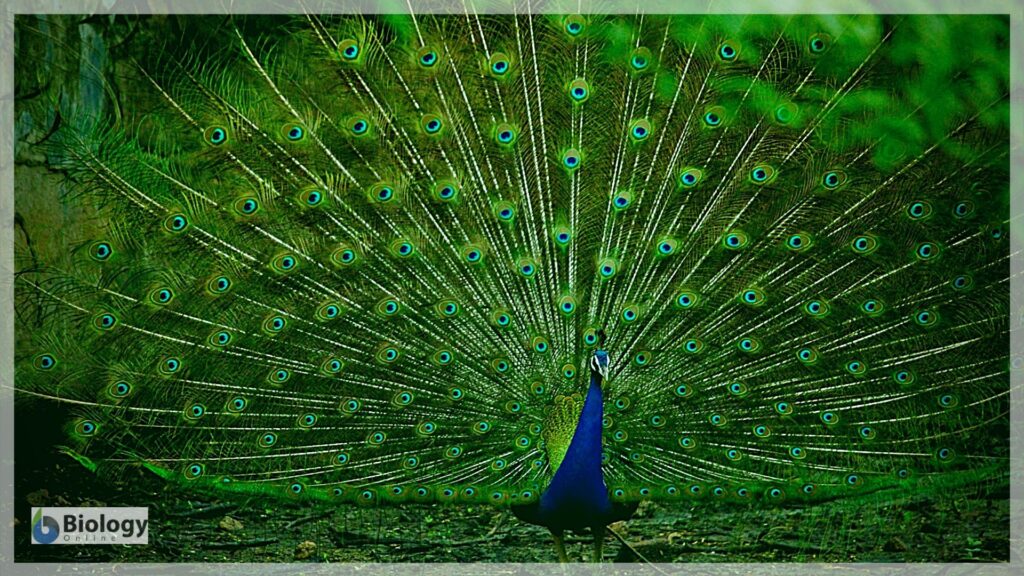
White, black, and brown mice
How does natural selection lead to evolution? As noted earlier, natural selection is the driving force of evolution. It is usually referred to as evolution by way of natural selection. Let’s take a look at a mouse population with varying fur colors — white, black, and brown. White mice are vulnerable to predators as their color easily be spotted. So, the white color characteristics will not be passed on, to the next generation. However, brown and brown mice can hide from predators as they are easily camouflaged with the environment. That means they will be able to pass the black/brown color traits to the next generation. In this case, natural selection drives the evolution of mice to be primarily black or brown.
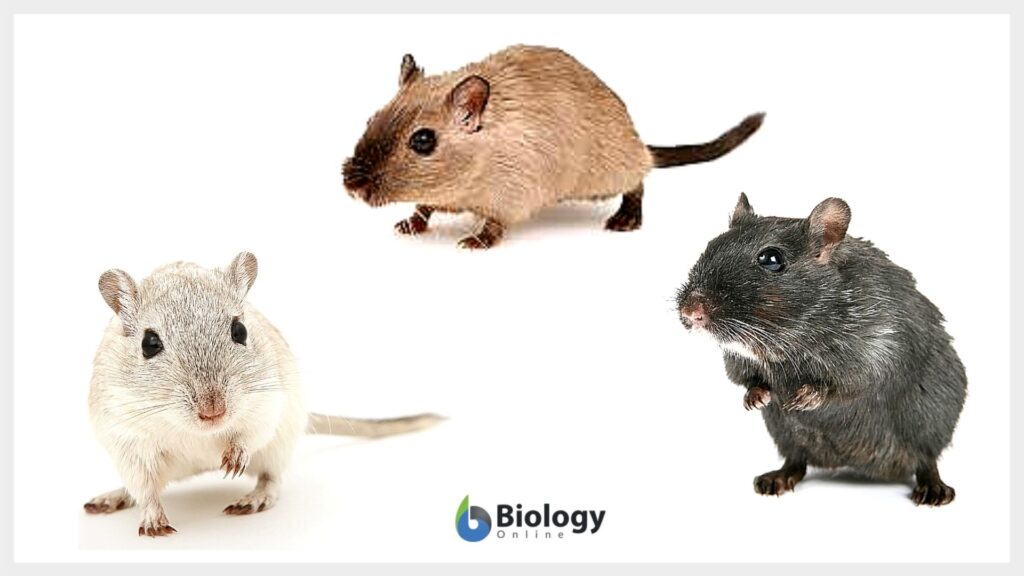
Long-necked vs. short-necked giraffes
In an environment where some giraffes have long necks while others have a short-neck. If something happens to that environment in which all low-lying shrubs die out. Then, the short-neck giraffes would not get enough food to survive. After several generations, only long-neck giraffes will be available in the area. In this scenario, natural selection boosts the preservation of the group of organisms that are best suited to the biological and physical changes of their environment.
Gray vs. green treefrogs
In a wooded area, gray treefrogs and green treefrogs share a common habitat – the bark of the tree- and an ecological niche. Snakes and birds are the predators of the tree frogs. On the bark of the tree, gray treefrogs blend better than green treefrogs. So, green treefrogs are more visible for predators to find and likely to be eaten. Over time gray treefrogs produce more offspring that are less likely to be eaten. In this case, natural selection has favored treefrogs that live in habitats in which they are more camouflaged. Besides, there are many ways natural selection shapes organisms.
Red vs. green bugs
Red bugs and green bugs share a habitat. The birds are the predator of the area that prefer to eat red bugs than the green ones. Soon, green bugs increase in numbers while red bugs decrease or become extinct in the area. In this case, the differential reproduction of the bugs depends on the food preference of the predator. Reproductive success is considered a significant determinant of groups that are favored by the process of natural selection.
Penguins, flightless birds
Penguin, for example, is a flightless bird that seems not a fit candidate for survival. However, instead of flying, penguins adapted to be good swimmers. Which, in turn, benefits them greatly in finding food and escaping predators. Since the area wherein penguins lives have no land predators and the source of food is in water. Losing the ability to fly is not a disadvantage for them.
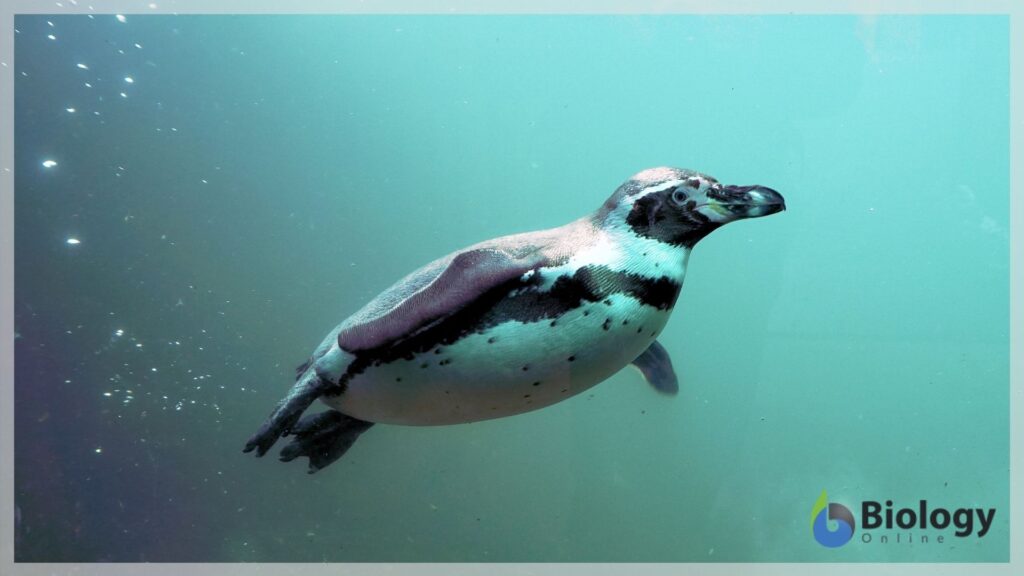
Venus flytrap
Natural selection also occurs in plants like, for example, the Venus Flytrap. These plants are carnivorous and grow in areas wherein soil lacks nitrogen. By nature, plants need nitrogen, a chemical element necessary for survival. For the Venus flytrap to survive in such an environment, they capture insects in a trap-like, as insects contain nitrogen and become an alternative source for the plants to survive in the poor-nitrogen habitat.
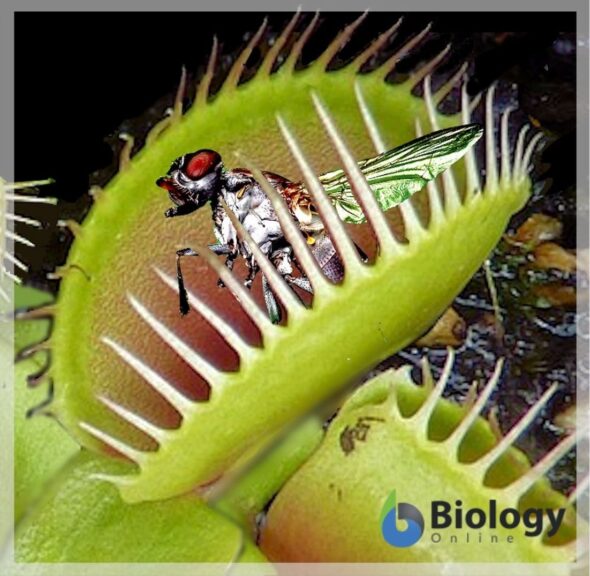
Green and brown beetles
Another example of natural selection is green and brown beetles that live on the ground. Green beetles are easy to spot by birds since they are more visible in the brown environment. Over time, mostly brown beetles remain in the population as the green ones are eaten by the birds. When changes occur in the area, the ground will be filled with grass due to climate change. Then, the brown beetles now are spotted easily by birds. Consequently, their population size may decrease. However, the few green beetles that are left will eventually increase in numbers as they are suited to survive in their new environment. Therefore, random effects of descent with modification become the evolution of the beetles to adapt to their environment through natural selection. The traits that have a better adaptation to the environment are then passed on while those traits that are not well-adapted will not survive.
Sharks
Sharks manifest defensive coloration where white-colored on the underside and blue-gray on the top. This coloration makes them camouflaged in the water, where the top blends the bluish water from someone looking down. Whereas, the white color underside of the shark balances the lights coming through the water from above.
Try to answer the quiz below to check what you have learned so far about Natural Selection.
References
- Bouchard, F. (2004). Fitness, Probability and the Principles of Natural Selection. The British Journal for the Philosophy of Science, 55(4), 693–712. https://doi.org/10.1093/bjps/55.4.693
- Brown, B. (2007). Evolution: A Historical Perspective (Greenwood Guides to Great Ideas in Science) (Illustrated ed.). Greenwood.
- Darwin, C. (2010). On the Origin of Species By Means of Natural Selection, or, the Preservation of Favoured Races in the Struggle for Life. FQ Books.
- Darwin, C., & Dawkins, R. (2003). The Origin of Species and the Voyage of the Beagle (Illustrated ed.). Everyman’s Library.
- Demetrius, L., & Gundlach, V. (2014). Directionality Theory and the Entropic Principle of Natural Selection. Entropy, 16(10), 5428–5522. https://doi.org/10.3390/e16105428
- Edwards, A. W. F. (1974). On Kimura’s maximum principle in the genetical theory of natural selection. Advances in Applied Probability, 6(01), 10–13. https://doi.org/10.1017/s0001867800039641
- Hendry, A. P., Kinnison, M. T., Heino, M., Day, T., Smith, T. B., Fitt, G., Bergstrom, C. T., Oakeshott, J., Jørgensen, P. S., Zalucki, M. P., Gilchrist, G., Southerton, S., Sih, A., Strauss, S., Denison, R. F., & Carroll, S. P. (2011). Evolutionary principles and their practical application. Evolutionary Applications, 4(2), 159–183. https://doi.org/10.1111/j.1752-4571.2010.00165.x
- Hunt, J. (1866). On the Application of the Principle of Natural Selection to Anthropology, in Reply to Views Advocated by Some of Mr. Darwin’s Disciples. Anthropological Review, 4(15), 320. https://doi.org/10.2307/3024857
- Pre-Darwinian Evolutionary Theory. (2015). Homestead.Com. http://scienceprofonline.homestead.com/evolution/pre-darwinian-evolutionary-theory-lamark-cuvier-hutton-lyell.html
- Uniformitarianism: Charles Lyell. (2020). Berkeley.Edu. https://evolution.berkeley.edu/evolibrary/article/0_0_0/history_12
- Urry, L., Cain, M., Wasserman, S., Minorsky, P., & Reece, J. (2016). Campbell Biology (Campbell Biology Series) (11th ed.). Pearson.
- Why Lamarck did not discover the principle of natural selection. (1982). Journal of the History of Biology, 15(3), 443–465. https://doi.org/10.1007/bf00133146
- Williams, G. C. (1966). Natural Selection, the Costs of Reproduction, and a Refinement of Lack’s Principle. The American Naturalist, 100(916), 687–690. https://doi.org/10.1086/282461
©BiologyOnline.com. Content provided and moderated by BiologyOnline Editors.


